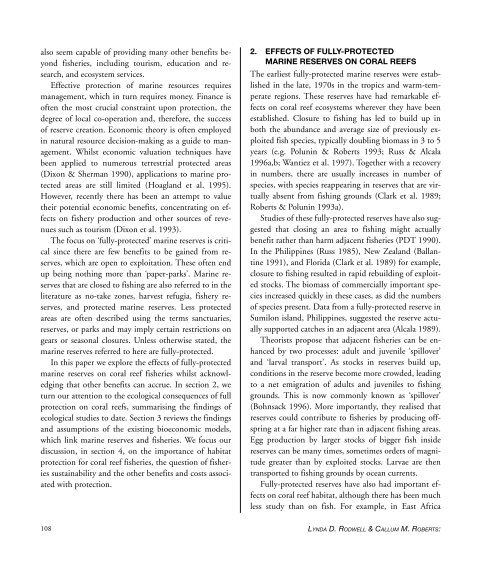Create successful ePaper yourself
Turn your PDF publications into a flip-book with our unique Google optimized e-Paper software.
also seem capable <strong>of</strong> providing many other benefits beyond<br />
fisheries, including tourism, education and research,<br />
and ecosystem services.<br />
Effective protection <strong>of</strong> marine resources requires<br />
management, which in turn requires money. Finance is<br />
<strong>of</strong>ten the most crucial constraint upon protection, the<br />
degree <strong>of</strong> local co-operation and, therefore, the success<br />
<strong>of</strong> reserve creation. Economic theory is <strong>of</strong>ten employed<br />
in natural resource decision-making as a guide to management.<br />
Whilst economic valuation techniques have<br />
been applied to numerous terrestrial protected areas<br />
(Dixon & Sherman 1990), applications to marine protected<br />
areas are still limited (Hoagland et al. 1995).<br />
However, recently there has been an attempt to value<br />
their potential economic benefits, concentrating on effects<br />
on fishery production and other sources <strong>of</strong> revenues<br />
such as tourism (Dixon et al. 1993).<br />
The focus on ‘fully-protected’ marine reserves is critical<br />
since there are few benefits to be gained from reserves,<br />
which are open to exploitation. These <strong>of</strong>ten end<br />
up being nothing more than ‘paper-parks’. Marine reserves<br />
that are closed to fishing are also referred to in the<br />
literature as no-take zones, harvest refugia, fishery reserves,<br />
and protected marine reserves. Less protected<br />
areas are <strong>of</strong>ten described using the terms sanctuaries,<br />
reserves, or parks and may imply certain restrictions on<br />
gears or seasonal closures. Unless otherwise stated, the<br />
marine reserves referred to here are fully-protected.<br />
In this paper we explore the effects <strong>of</strong> fully-protected<br />
marine reserves on coral reef fisheries whilst acknowledging<br />
that other benefits can accrue. In section 2, we<br />
turn our attention to the ecological consequences <strong>of</strong> full<br />
protection on coral reefs, summarising the findings <strong>of</strong><br />
ecological studies to date. Section 3 reviews the findings<br />
and assumptions <strong>of</strong> the existing bioeconomic models,<br />
which link marine reserves and fisheries. We focus our<br />
discussion, in section 4, on the importance <strong>of</strong> habitat<br />
protection for coral reef fisheries, the question <strong>of</strong> fisheries<br />
sustainability and the other benefits and costs associated<br />
with protection.<br />
2. EFFECTS OF FULLY-PROTECTED<br />
MARINE RESERVES ON CORAL REEFS<br />
The earliest fully-protected marine reserves were established<br />
in the late, 1970s in the tropics and warm-temperate<br />
regions. These reserves have had remarkable effects<br />
on coral reef ecosystems wherever they have been<br />
established. Closure to fishing has led to build up in<br />
both the abundance and average size <strong>of</strong> previously exploited<br />
fish species, typically doubling biomass in 3 to 5<br />
years (e.g. Polunin & Roberts 1993; Russ & Alcala<br />
1996a,b; Wantiez et al. 1997). Together with a recovery<br />
in numbers, there are usually increases in number <strong>of</strong><br />
species, with species reappearing in reserves that are virtually<br />
absent from fishing grounds (Clark et al. 1989;<br />
Roberts & Polunin 1993a).<br />
Studies <strong>of</strong> these fully-protected reserves have also suggested<br />
that closing an area to fishing might actually<br />
benefit rather than harm adjacent fisheries (PDT 1990).<br />
In the Philippines (Russ 1985), New Zealand (Ballantine<br />
1991), and Florida (Clark et al. 1989) for example,<br />
closure to fishing resulted in rapid rebuilding <strong>of</strong> exploited<br />
stocks. The biomass <strong>of</strong> commercially important species<br />
increased quickly in these cases, as did the numbers<br />
<strong>of</strong> species present. Data from a fully-protected reserve in<br />
Sumilon island, Philippines, suggested the reserve actually<br />
supported catches in an adjacent area (Alcala 1989).<br />
Theorists propose that adjacent fisheries can be enhanced<br />
by two processes: adult and juvenile ‘spillover’<br />
and ‘larval transport’. As stocks in reserves build up,<br />
conditions in the reserve become more crowded, leading<br />
to a net emigration <strong>of</strong> adults and juveniles to fishing<br />
grounds. This is now commonly known as ‘spillover’<br />
(Bohnsack 1996). More importantly, they realised that<br />
reserves could contribute to fisheries by producing <strong>of</strong>fspring<br />
at a far higher rate than in adjacent fishing areas.<br />
Egg production by larger stocks <strong>of</strong> bigger fish inside<br />
reserves can be many times, sometimes orders <strong>of</strong> magnitude<br />
greater than by exploited stocks. Larvae are then<br />
transported to fishing grounds by ocean currents.<br />
Fully-protected reserves have also had important effects<br />
on coral reef habitat, although there has been much<br />
less study than on fish. For example, in East Africa<br />
108<br />
LYNDA D. RODWELL & CALLUM M. ROBERTS:


















